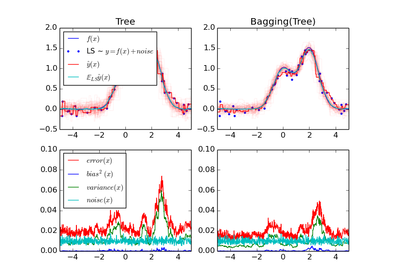sklearn.ensemble.BaggingRegressor¶
- class sklearn.ensemble.BaggingRegressor(base_estimator=None, n_estimators=10, max_samples=1.0, max_features=1.0, bootstrap=True, bootstrap_features=False, oob_score=False, n_jobs=1, random_state=None, verbose=0)¶
A Bagging regressor.
A Bagging regressor is an ensemble meta-estimator that fits base regressors each on random subsets of the original dataset and then aggregate their individual predictions (either by voting or by averaging) to form a final prediction. Such a meta-estimator can typically be used as a way to reduce the variance of a black-box estimator (e.g., a decision tree), by introducing randomization into its construction procedure and then making an ensemble out of it.
This algorithm encompasses several works from the literature. When random subsets of the dataset are drawn as random subsets of the samples, then this algorithm is known as Pasting [R23]. If samples are drawn with replacement, then the method is known as Bagging [R24]. When random subsets of the dataset are drawn as random subsets of the features, then the method is known as Random Subspaces [R25]. Finally, when base estimators are built on subsets of both samples and features, then the method is known as Random Patches [R26].
Parameters: base_estimator : object or None, optional (default=None)
The base estimator to fit on random subsets of the dataset. If None, then the base estimator is a decision tree.
n_estimators : int, optional (default=10)
The number of base estimators in the ensemble.
max_samples : int or float, optional (default=1.0)
- The number of samples to draw from X to train each base estimator.
- If int, then draw max_samples samples.
- If float, then draw max_samples * X.shape[0] samples.
max_features : int or float, optional (default=1.0)
- The number of features to draw from X to train each base estimator.
- If int, then draw max_features features.
- If float, then draw max_features * X.shape[1] features.
bootstrap : boolean, optional (default=True)
Whether samples are drawn with replacement.
bootstrap_features : boolean, optional (default=False)
Whether features are drawn with replacement.
oob_score : bool
Whether to use out-of-bag samples to estimate the generalization error.
n_jobs : int, optional (default=1)
The number of jobs to run in parallel for both fit and predict. If -1, then the number of jobs is set to the number of cores.
random_state : int, RandomState instance or None, optional (default=None)
If int, random_state is the seed used by the random number generator; If RandomState instance, random_state is the random number generator; If None, the random number generator is the RandomState instance used by np.random.
verbose : int, optional (default=0)
Controls the verbosity of the building process.
Attributes: `estimators_`: list of estimators :
The collection of fitted sub-estimators.
`estimators_samples_`: list of arrays :
The subset of drawn samples (i.e., the in-bag samples) for each base estimator.
`estimators_features_`: list of arrays :
The subset of drawn features for each base estimator.
`oob_score_` : float
Score of the training dataset obtained using an out-of-bag estimate.
`oob_decision_function_` : array of shape = [n_samples, n_classes]
Decision function computed with out-of-bag estimate on the training set. If n_estimators is small it might be possible that a data point was never left out during the bootstrap. In this case, oob_decision_function_ might contain NaN.
References
[R23] (1, 2) L. Breiman, “Pasting small votes for classification in large databases and on-line”, Machine Learning, 36(1), 85-103, 1999. [R24] (1, 2) L. Breiman, “Bagging predictors”, Machine Learning, 24(2), 123-140, 1996. [R25] (1, 2) T. Ho, “The random subspace method for constructing decision forests”, Pattern Analysis and Machine Intelligence, 20(8), 832-844, 1998. [R26] (1, 2) G. Louppe and P. Geurts, “Ensembles on Random Patches”, Machine Learning and Knowledge Discovery in Databases, 346-361, 2012. Methods
fit(X, y[, sample_weight]) Build a Bagging ensemble of estimators from the training set (X, y). get_params([deep]) Get parameters for this estimator. predict(X) Predict regression target for X. score(X, y[, sample_weight]) Returns the coefficient of determination R^2 of the prediction. set_params(**params) Set the parameters of this estimator. - __init__(base_estimator=None, n_estimators=10, max_samples=1.0, max_features=1.0, bootstrap=True, bootstrap_features=False, oob_score=False, n_jobs=1, random_state=None, verbose=0)¶
- fit(X, y, sample_weight=None)¶
- Build a Bagging ensemble of estimators from the training
- set (X, y).
Parameters: X : {array-like, sparse matrix} of shape = [n_samples, n_features]
The training input samples. Sparse matrices are accepted only if they are supported by the base estimator.
y : array-like, shape = [n_samples]
The target values (class labels in classification, real numbers in regression).
sample_weight : array-like, shape = [n_samples] or None
Sample weights. If None, then samples are equally weighted. Note that this is supported only if the base estimator supports sample weighting.
Returns: self : object
Returns self.
- get_params(deep=True)¶
Get parameters for this estimator.
Parameters: deep: boolean, optional :
If True, will return the parameters for this estimator and contained subobjects that are estimators.
Returns: params : mapping of string to any
Parameter names mapped to their values.
- predict(X)¶
Predict regression target for X.
The predicted regression target of an input sample is computed as the mean predicted regression targets of the estimators in the ensemble.
Parameters: X : {array-like, sparse matrix} of shape = [n_samples, n_features]
The training input samples. Sparse matrices are accepted only if they are supported by the base estimator.
Returns: y : array of shape = [n_samples]
The predicted values.
- score(X, y, sample_weight=None)¶
Returns the coefficient of determination R^2 of the prediction.
The coefficient R^2 is defined as (1 - u/v), where u is the regression sum of squares ((y_true - y_pred) ** 2).sum() and v is the residual sum of squares ((y_true - y_true.mean()) ** 2).sum(). Best possible score is 1.0, lower values are worse.
Parameters: X : array-like, shape = (n_samples, n_features)
Test samples.
y : array-like, shape = (n_samples,)
True values for X.
sample_weight : array-like, shape = [n_samples], optional
Sample weights.
Returns: score : float
R^2 of self.predict(X) wrt. y.
- set_params(**params)¶
Set the parameters of this estimator.
The method works on simple estimators as well as on nested objects (such as pipelines). The former have parameters of the form <component>__<parameter> so that it’s possible to update each component of a nested object.
Returns: self :


